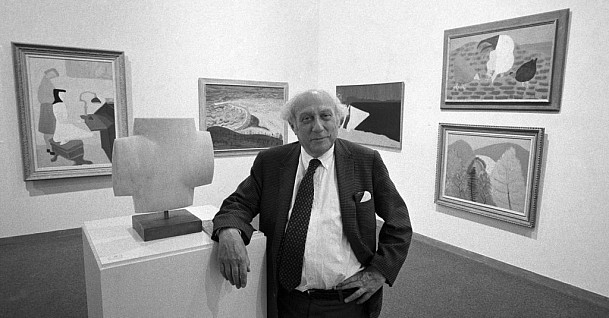Who is Roy R. Neuberger?: Part 1
It’s safe to say that most Purchase College students—including this year’s new Freshmen—have heard of the “NEU” but many of you may not be as familiar with its origin and namesake, Roy R. Neuberger. I did some research and wanted to share with you some of what I found out about the Museum’s founding donor.
By Gabrielle Bohrman, NEU Student Voices Blogger (Fall 2022)
Mr. Neuberger, who is considered one of the greatest patrons and arts advocates of the 20th century, made a promised gift of 300 pieces from his personal art collection to establish the Neuberger Museum as the first building to break ground on campus in 1969. By the time he passed away at the age of 107, Mr. Neuberger subsequently left behind a legacy of 985 donated works in total to the Museum and introduced over 400 emerging artists to the Purchase College community.
At the beginning of his philanthropic career, Mr. Neuberger made a commitment to support living artists. While traveling and studying art in Paris as a young man, he was disturbed by the fact that most Impressionist and Post-Impressionist artists were not appreciated and compensated while alive. Vincent Van Gogh for example, had only sold one painting in his lifetime.
Mr. Neuberger started working on Wall Street in 1929 with a plan to save enough money to build his art collection. By the 1940s, he entered the New York City art scene and began purchasing art primarily from galleries, often, shortly following the work’s completion.
“Roy R. Neuberger had very strong relationships with gallerists and through them, met many artists with whom he became friends.” says Neuberger Museum of Art’s provenance researcher Beth Silver. “It gave him a very personal look at and connection with artists.”
Over time he collected paintings, drawings, collages and sculptures from hundreds of groundbreaking 20th century American artists. These Modern Art luminaries, such as Alexander Calder, William de Kooning, Georgia O’Keeffe, and Jackson Pollock, were considered contemporary during Mr. Neuberger’s time. He bought directly through the artists’ gallerists and sometimes directly from the artists, ensuring that they were paid and received the recognition they deserved.

- Roy R. Neuberger
Many of his favorite pieces were displayed in his New York apartment and in the investment management firm, Neuberger and Berman, that he founded with Robert Berman. Over time he donated and lent pieces of his collection to 70 different museums and educational institutions in 24 states including the Whitney Museum of American Art, The Metropolitan Museum of Art, and the Museum of Modern Art. Though asked, he never sold artwork purchased from a living artist. His widespread donations played an integral role in introducing American art audiences to new, unseen emerging artists and modern art styles.
Mr. Neuberger’s contributions and artistic literacy attracted many art advocacy organizations and the American Federation of the Arts elected him president in 1958. One of his first acts as president was to publicly endorse the U.S Senate’s approval of a bill to create a National Cultural Center in Washington D.C, an institution that would eventually become what is today’s John F. Kennedy Center for the Performing Arts.
Even prior to endowing the Neuberger Museum in 1969, Mr. Neuberger supported many academic institutions with monetary and artwork donations including Mount Holyoke, Bryn Mawr and the University of Michigan. He always maintained his philosophy of supporting living artists, and often requested that the institution match his gift by purchasing another work by the same artist to help further the artist’s career.
Stay tuned for a follow-up blog post exploring Mr. Neuberger’s role in the birth of Purchase College and the Neuberger Museum!
Gabrielle Bohrman
Neuberger Museum of Art
Fall 2020 Communications Intern
NEU Student Voices Blogger